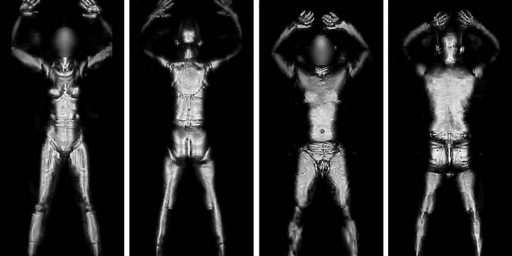PILLOW BOMBS?
Oh, great: MSNBC reports,
Airport screeners in this country and overseas are on the lookout for suspicious pillows, coats and even stuffed animals after U.S. intelligence concluded that al Qaeda operatives are being trained to apply special chemicals to the material inside to transform them into bombs.
AMERICAN INTELLIGENCE OFFICIALS have picked up several indications that al Qaeda is attempting to create a chemical called nitrocellulose to fashion explosive devices that could be smuggled aboard jetliners, according to a warning the Department of Homeland Security sent in August to airlines and airport security officials around the world.
“We judge this type of threat to be real and continuing,” the department said in the Aug. 8 warning. It noted there has been “persistence [in a] line of reports from several credible, independent sources” that al Qaeda is training to build such bombs. Among other things, confiscated al Qaeda training manuals show the sophistication of its preparations, the document said.
Explosives experts said that the detonating power of a nitrocellulose bomb depends on numerous factors — but most particularly on how tightly the cottonlike material is packed into an area. If small free-standing wisps of it are set on fire, they could blaze up quickly and die down just as fast. But large wads of it tightly crammed into a container of some kind could create a booming detonation, they said.
This is going to make getting through airport security fun.






As anyone in security knows, you can’t eliminate all threats. The illusion that we can be completely safe is just that. And so goes the theory that you make better relations and solve the root problems, rather than the provably impossible flip side of making yourself completely safe.
But that’s just a liberal position.
Or you can get busy killing the terrorists, I guess.
Frankly, I’m not sure making them all happy enough to quit being terrorists is a feasible policy.
But what if we all hold hands and sing kumbaya?
That should make them not hate us… RIght?? Right???
The biggest problem with nitrocellulose is that you can light it with a match.
And while I agree with John’s point that you can not eliminate all risk in life I also know that if a nitrocellulose pillow blows a plane up tomorrow, John will be shouting from the roof top that Bush should have done something about it.
Another liberal position.
Paul
FYI: This isn’t exactly new technology; it’s origins go back well over 100 years.
“nitrocellulose, nitric acid ester of cellulose (a glucose polymer). It is usually formed by the action of a mixture of nitric and sulfuric acids on purified cotton or wood pulp. The extent of nitration and degradation (breaking down) of the cellulose is carefully controlled in order to obtain the desired product. When cotton is treated so that nearly all of the hydroxyl groups of the cellulose molecule are esterified, but with little or no degradation of the molecular structure, the nitrocellulose formed is called guncotton. Guncotton resembles cotton in its appearance. Extremely flammable, it explodes when detonated and is used in the manufacture of explosives. Guncotton is insoluble in such common solvents as water, chloroform, ether, and ethanol. If the nitration is not carried to completion (the point at which about two thirds of the hydroxyl groups are esterified), the soluble cellulose nitrate pyroxylin is formed.”
http://www.factmonster.com/ce6/sci/A0835741.html
Also…
“Although initially used in the manufacture of smokeless powder, DuPont’s nitrocellulose production led to the company’s diversification into non-explosive chemicals and finished goods. In the 1830s and 1840s, European chemists discovered that cotton dipped in nitric acid produced an explosive material. However, this early form of nitrocellulose was too unstable to be used safely in explosives production. Scientists later converted nitrocellulose into a stable base for an improved gunpowder known as smokeless powder. DuPont developed its own smokeless powder in the 1890s and became the leading manufacturer of the explosive for the U.S. military during World War I and World War II.
In addition to explosives, experiments revealed that a combination of nitrated cotton or wood pulp with ether and alcohol produced a non-explosive solution that hardened into a film. This discovery led to a wide array of end uses for nitrocellulose including plastics, lacquers and photographic film. Following the 1902 change in management at DuPont, the company looked to diversify into these new end uses for excess nitrocellulose production. In 1904 DuPont bought the International Smokeless Powder and Chemical Company which, in addition to smokeless powder, produced nitrocellulose lacquers. The 1910 purchase of the Fabrikoid Company brought DuPont into the production of artificial leather for the automobile industry. Acquisition of nitrocellulose-based companies was capped by the 1915 purchase of the Arlington Company, a manufacturer of pyroxylin plastics. DuPont continued to improve these products and develop new ones like Duco, a durable nitrocellulose lacquer that revolutionized the automotive finish business. The company first moved beyond nitrocellulose-based products in 1917 when it purchased the Harrison Brothers Paint Company. Thereafter, DuPont increasingly directed its diversification efforts into new chemical research for industrial and consumer products.”
http://heritage.dupont.com/floater/fl_nitrocellulose/floater.shtml
The hilarious thing about this “threat” is that to make nitrocellulose, you have to dry it out after dunking the cotton into the acid mixture. So, while it’s technically possible to do the initial steps, I can’t imagine that anyone could actually dry the mess up in time to do anything at all. The drying has to be done at less than 100 degrees Celsius, which means that you’re in for a long, long, long wait for any quantities capable of doing any damage. And the acid fumes that come out of the process during the drying would be extremely hard for anyone to miss. Thus, they’d be caught within 1/2 an hour of even attempting this.
Also, like all explosives, it isn’t the explosion itself that’s the devastating part, it’s the actual directing of the explosive blast that is required.
You can have a stick of dynamite go off in the seat next to you and, apart from your hearing, it won’t do much damage at all. This is something that anyone who’s played with explosives know.
I think this is all a bunch of hooey for the most part. But who knows. Terrorists are clever.
And Paul, you’re wrong. I work in the security field, and I understand what an attack tree analysis means. I’m a realist. Take 9/11, for example. It’s my belief that all the steps taken in airport security since 9/11 mostly have zero effect on preventing it from happening again. The Air Marshals was an excellent plan, but considering that almost anything with a sharp edge – say a wine bottle broken – would do, it’s hard to see how anything else they’ve done really improves security.
Rather, it’s a safety blanket that makes you feel better than actually doing anything to make you safer. Something that is very, very dangerous (false security is worse than no security).
So, if it happens again – and I’m hoping to “Bob” that it won’t – I won’t be blaming anyone for it – other than the terrorists.
I’ll just be blaming the idiotic belief that being a bully will remove the threats from your life.
Ah, I see the article makes much the same points as I do. Oh well.
John, I don’t think anyone was saying they would manufacture it on the plane. The drying would certainly be done before one fashioned it into a pillow.
And as far and tamping it to make it explosive and not just highly flammable, just stuff it between the seat and the outside skin of the craft. Or have another accomplice carry a vessel of some kind and they work together.
And as for you not blaming Bush if this happens I would love to give you the benefit of the doubt….
But you have lied about other things too then quite proudly proclaimed you would lie about them in the future… Therefor I am forced to believe you are lying about this.
—